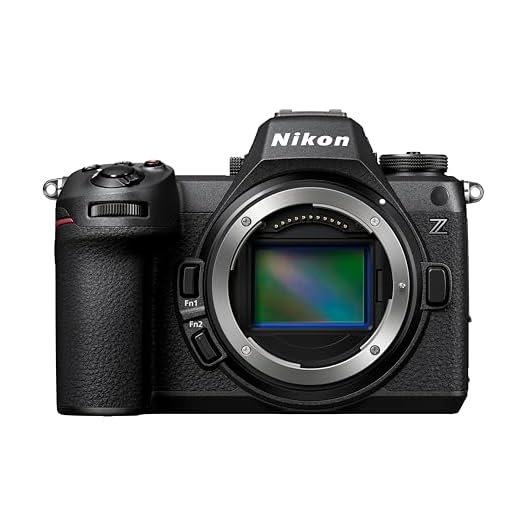Nikon Z6 III vs Nikon Z6 II
Choosing the right camera can significantly impact your photography and videography experience. The Nikon Z6 II and Nikon Z6 III are two prominent models in the mirrorless camera market, each offering unique features and improvements over the other. This introduction delves into the key parameters potential buyers consider when choosing between these two models, providing a detailed comparison to help make an informed decision.
Comparison Table – Nikon Z6 III vs Nikon Z6 II
| Feature | Nikon Z6 II | Nikon Z6 III |
|---|---|---|
| Design | ||
| TYPE | Mirrorless | Mirrorless |
| VIEWFINDER | Electronic viewfinder (EVF) | Electronic viewfinder (EVF) |
| IS WEATHER-SEALED (SPLASHPROOF) | ✔ | ✔ |
| SCREEN RESOLUTION | 2100k dots | 2100k dots |
| EVF RESOLUTION | 3690k dots | 5670k dots |
| HAS A BUILT-IN FOCUS MOTOR | ✖ | ✖ |
| HAS A FLIP-OUT SCREEN | ✔ | ✔ |
| VIEWFINDER COVERAGE | 100% | 100% |
| SCREEN SIZE | 3.2″ | 3.1″ |
| WEIGHT | 705 g | 760 g |
| HAS A TOUCH SCREEN | ✔ | ✔ |
| HAS A HOT SHOE | ✔ | ✔ |
| VOLUME | 935.96 cm³ | 1040.27 cm³ |
| IS A SYSTEM CAMERA | ✔ | ✔ |
| HAS A FLASH | ✖ | ✖ |
| LOWEST POTENTIAL OPERATING TEMPERATURE | 0 °C | -14 °C |
| MAXIMUM OPERATING TEMPERATURE | 40 °C | 40 °C |
| HAS A TILTING VIEWFINDER | ✖ | ✖ |
| EVF REFRESH RATE (MAX) | 0fps | |
| WIDTH | 134 mm | 138.5 mm |
| HEIGHT | 100.5 mm | 74 mm |
| THICKNESS | 69.5 mm | 101.5 mm |
| Optics | ||
| SENSOR SIZE | Full frame | Full frame |
| LENS MOUNT | Nikon Z | Nikon Z |
| FOCUS POINTS | 273 | 273 |
| MEGAPIXELS (MAIN CAMERA) | 24.5 MP | 24.5 MP |
| MAXIMUM ISO | 51200 ISO | 64000 ISO |
| MAXIMUM EXPANDED ISO | 204800 ISO | 204800 ISO |
| HAS SENSOR SHIFT STABILIZATION | ✔ | ✔ |
| CONTINUOUS SHOOTING (MECHANICAL) | 14 fps | 14 fps |
| HAS AF TRACKING | ✔ | ✔ |
| HAS PHASE-DETECTION AUTOFOCUS FOR PHOTOS | ✔ | ✔ |
| FASTEST SHUTTER SPEED | 1/8000 s | 1/8000 s |
| HAS MANUAL FOCUS | ✔ | ✔ |
| HAS TOUCH AUTOFOCUS | ✔ | ✔ |
| HAS MANUAL SHUTTER SPEED | ✔ | ✔ |
| HAS A BUILT-IN HDR MODE | ✔ | ✔ |
| HAS A BSI SENSOR | ✔ | ✔ |
| HAS MANUAL EXPOSURE | ✔ | ✔ |
| HAS A TWO-STAGE SHUTTER | ✔ | ✔ |
| HAS A SERIAL SHOT MODE | ✔ | ✔ |
| HAS A CMOS SENSOR | ✔ | ✔ |
| HAS MANUAL ISO | ✔ | ✔ |
| FLASH SYNC SPEED | 1/200 s | 1/200 s |
| HAS MANUAL WHITE BALANCE | ✔ | ✔ |
| CAN CREATE PANORAMAS IN-CAMERA | ✖ | ✖ |
| EXPOSURE TIME | 900 s | 30 s |
| MAXIMUM ELECTRONIC SHUTTER SPEED | Unknown | 1/16000 s |
| SHUTTER LAG | Unknown | Unknown |
| EXPEED VERSION | 6 | Not applicable |
| HAS A STACKED CMOS SENSOR | ✖ | ✖ |
| IMAGE STABILIZATION RATING (CIPA) | Unknown | 8 stops |
| CAN COMBINE IMAGE STABILIZATION | ✖ | ✔ |
| Videography | ||
| VIDEO RECORDING (MAIN CAMERA) | 2160 x 60 fps | 3024 x 60 fps |
| HAS PHASE-DETECTION AUTOFOCUS FOR VIDEOS | ✔ | ✔ |
| HAS CONTINUOUS AUTOFOCUS WHEN RECORDING MOVIES | ✔ | ✔ |
| HAS A MICROPHONE INPUT | ✔ | ✔ |
| HAS A SOCKET FOR A 3.5 MM AUDIO JACK | ✔ | ✖ |
| HAS A STEREO MICROPHONE | ✔ | ✔ |
| HAS TIMELAPSE FUNCTION | ✔ | ✔ |
| MOVIE BITRATE | 144 Mbps | n.a. |
| NUMBER OF MICROPHONES | 2 | 2 |
| HAS A 24P CINEMA MODE | ✔ | ✔ |
| SUPPORTS SLOW-MOTION VIDEO RECORDING | ✔ | ✔ |
| Battery | ||
| BATTERY LIFE (CIPA) | 410 shots | 380 shots |
| HAS A REMOVABLE BATTERY | ✔ | ✔ |
| HAS A RECHARGEABLE BATTERY | ✔ | ✔ |
| HAS A BATTERY LEVEL INDICATOR | ✔ | ✔ |
| BATTERY POWER | 2280 mAh | 2100 mAh |
| Features | ||
| SUPPORTS WI-FI | ✔ | ✔ |
| HAS BLUETOOTH | ✔ | ✔ |
| HAS DUAL CARD SLOTS | ✔ | ✔ |
| HAS PIXEL SHIFT SHOT | ✖ | ✖ |
| SHOOTS RAW | ✔ | ✔ |
| SUPPORTS LOSSLESS COMPRESSED RAW | ✖ | ✔ |
| WI-FI VERSION | Wi-Fi 5 (802.11ac), Wi-Fi 4 (802.11n) | Wi-Fi 5 (802.11ac), Wi-Fi 4 (802.11n) |
| SUPPORTS A REMOTE SMARTPHONE | ✔ | ✔ |
| HAS AN HDMI OUTPUT | ✔ | ✔ |
| HAS GPS | ✖ | ✖ |
| HAS FIRST-PARTY SUPPORT FOR LIVE STREAMING | ✖ | ✖ |
| HAS AN ADVANCED HOT SHOE | ✖ | ✖ |
| DXOMARK SENSOR SCORE | 94 | Unknown |
| DXOMARK SPORTS SCORE | 3303 ISO | Unknown |
| DXOMARK LANDSCAPE SCORE | 14.4 EV | Unknown |
| DXOMARK PORTRAIT SCORE | 25 bits | Unknown |
| USB VERSION | 3 | 3.2 |
| HDMI VERSION | Unknown | Unknown |
| HAS NFC | ✔ | ✖ |
| HAS AN EXTERNAL MEMORY SLOT | ✔ | ✔ |
| INTERNAL STORAGE | Unknown | Not applicable |
| HAS USB TYPE-C | ✔ | ✔ |
| BLUETOOTH VERSION | 4.2 | 5 |
Design and Build Quality
Both the Nikon Z6 II and Z6 III are mirrorless cameras, equipped with an electronic viewfinder (EVF). The Z6 III offers a higher EVF resolution of 5670k dots compared to the Z6 II’s 3690k dots, delivering a sharper and more detailed view. Both models are weather-sealed, ensuring durability against dust, raindrops, and water splashes, which is crucial for outdoor and adventurous photographers.
Display and Viewfinder
The screen resolution of both models stands at 2100k dots, providing clear and sharp image reviews. The Z6 II features a slightly larger screen size of 3.2 inches, while the Z6 III has a 3.1-inch display. Both cameras have flip-out screens and touchscreens, enhancing usability for various shooting angles and scenarios. Notably, the Z6 III offers an EVF refresh rate of 0fps, which remains undisclosed for the Z6 II.
Weight and Portability
Portability is a significant factor for many photographers. The Z6 II is lighter at 705 grams, making it more convenient for travel and extended shoots. In contrast, the Z6 III weighs 760 grams, offering a balance between portability and robustness.
Image Quality and Performance
When it comes to image quality, both cameras feature a full-frame sensor with a resolution of 24.5 MP. However, the Z6 III offers a higher maximum ISO of 64000, compared to the Z6 II’s 51200, making it more versatile in low-light conditions. Both models support an expanded ISO of 204800, catering to various lighting situations.
Autofocus and Continuous Shooting
Autofocus performance is crucial for capturing sharp images, especially in dynamic situations. Both models offer 273 focus points, ensuring flexibility in selecting the focus area. They also feature advanced autofocus tracking and phase-detection autofocus, providing precise focus even on moving subjects. The continuous shooting speed for both cameras is 14 fps, making them suitable for capturing fast-moving subjects.
Video Capabilities
In terms of video recording, the Z6 III outshines the Z6 II with a maximum video resolution of 3024 x 60 fps, compared to the Z6 II’s 2160 x 60 fps. Both models support phase-detection autofocus for videos and continuous autofocus when recording movies, ensuring sharp and clear footage. The Z6 II includes a 3.5 mm audio jack, which the Z6 III lacks, providing more flexibility for connecting external audio equipment.
Battery Life and Connectivity
Battery life is another critical consideration. The Z6 II offers a longer battery life with 410 shots per charge, compared to the Z6 III’s 380 shots. Both cameras have removable, rechargeable batteries with a battery level indicator. Connectivity features include Wi-Fi and Bluetooth, with the Z6 III supporting Bluetooth version 5, an upgrade from the Z6 II’s version 4.2. Both models have dual card slots, providing ample storage for photos and videos.
Additional Features
The Z6 III introduces several enhancements over the Z6 II, such as an increased lowest operating temperature of -14 °C, compared to the Z6 II’s 0 °C, making it more suitable for extreme conditions. The Z6 III also supports a maximum electronic shutter speed of 1/16000 s, while this feature remains unspecified for the Z6 II. Additionally, the Z6 III offers 8 stops of image stabilization rating (CIPA) and the ability to combine image stabilization, which the Z6 II lacks.
In conclusion, both the Nikon Z6 II and Z6 III are exceptional mirrorless cameras, each with its strengths. The Z6 III offers several enhancements, such as higher EVF resolution, increased ISO capabilities, and improved video recording, making it a superior choice for professionals seeking advanced features. On the other hand, the Z6 II provides a lighter weight and longer battery life, making it ideal for travel and extended shoots. Understanding these key differences can help potential buyers make an informed decision based on their specific needs and preferences.
Also See:
Nikon Z6 II vs Nikon Z5 – Comprehensive Comparison
Apple Unveils macOS 15 Sequoia at WWDC 2024
Meta Unveils Revolutionary AI “Segment Anything Model”
——————————————————————————————————————————————
Techcazt, Tech Magazine. We provide you with the latest news, reviews, and insights on the most cutting-edge technology available today. Whether you’re a hardcore gamer, a tech enthusiast, or just looking for great deals on your favorite gadgets, we’ve got you covered. The articles published in our magazine are intended to provide general information and ideas related to Tech and related topics. We strive to provide accurate and up-to-date information, but readers should always conduct their own research and consult with professionals before making decisions. If you have any comments or suggestions, please comment below. You can also follow us on Facebook, Instagram, and Twitter. Do not forget to give us a LIKE and SUBSCRIBE.





